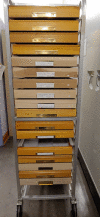Importance of building a digital species index (spindex) for entomology collections: A case study, results and recommendations
- PMID: 33390759
- PMCID: PMC7773715
- DOI: 10.3897/BDJ.8.e58310
Importance of building a digital species index (spindex) for entomology collections: A case study, results and recommendations
Abstract
The Entomology Collection at the Academy of Natural Sciences of Drexel University (ANSP) contains approximately four million insect specimens including some of the oldest in the Western Hemisphere. Like most large entomology collections, no complete inventory of the species represented in the collection was available and even a physical search for a species could not ensure that all available specimens would be recovered for study. Between 2010 and 2014, we created a species-level index (called here spindex) of all species and their specimen counts at ANSP, along with each species' location in the collection. Additional data captured during the project included the higher level classification of each species and type of specimen preparation. The spindex is searchable online: http://symbiont.ansp.org/entomology/. The spindex project documented 96,126 species in the ANSP Entomology Collection, representing about 10% of the described insect fauna. Additionally, over 900 putative primary types were discovered outside the Primary Type Collection. The completion of this project has improved access to the collection by enabling scientists and other users worldwide to search these collection holdings remotely and has facilitated staff in curation, research, collection management and funding proposals. A spindex is an important tool that is overlooked for planning and carrying out specimen level digitisation. This project is a case study for building a species-level index. A detailed protocol is provided, along with recommendations for other collections, including cost estimates and strategies for tracking progress and avoiding common obstacles.
Keywords: collection management; collections; curation; entomology; natural history; species index.
Stephen C. Mason, Jr., Isabelle S. Betancourt, Jon K. Gelhaus.
Figures












References
-
- Arnett Jr RH, Samuelson GA, Nishida GM. The insect and spider collections of the World. 2nd Edition. Sandhill Crane Press; Gainesville, FL: 1993.
-
- Bakker Freek T., Antonelli Alexandre, Clarke Julia A., Cook Joseph A., Edwards Scott V., Ericson Per G. P., Faurby Søren, Ferrand Nuno, Gelang Magnus, Gillespie Rosemary G., Irestedt Martin, Lundin Kennet, Larsson Ellen, Matos-Maraví Pável, Müller Johannes, von Proschwitz Ted, Roderick George K., Schliep Alexander, Wahlberg Niklas, Wiedenhoeft John, Källersjö Mari. The Global Museum: natural history collections and the future of evolutionary science and public education. https://peerj.com/articles/8225. PeerJ. 2020;8 doi: 10.7717/peerj.8225. - DOI - PMC - PubMed
-
- Cigliano MM, Braun H, Eades DC, Otte D. Orthoptera Species File. 2020. http://Orthoptera.SpeciesFile.org http://Orthoptera.SpeciesFile.org Version 5.0/5.0.
-
- Cobb Neil S., Gall Lawrence F., Zaspel Jennifer M., Dowdy Nicolas J., McCabe Lindsie M., Kawahara Akito Y. Assessment of North American arthropod collections: prospects and challenges for addressing biodiversity research. https://peerj.com/articles/8086. PeerJ. 2019;7 doi: 10.7717/peerj.8086. - DOI - PMC - PubMed
LinkOut - more resources
Full Text Sources
